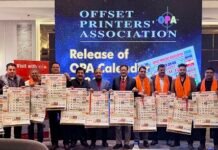Processless technologies have been around for decades with all sorts of companies having a go. Xe- rox, for instance, introduced a processless film called Verde way back in 1995.
Chemists have been striving to minimise production and reduce chemical use and waste but have struggled with plate imaging being slow, fuzzy and expensive.
Most problems have been solved, apart from cost. Processless plates remove the non-image area from a plate’s surface either with ab- lation, phase change or wash-off technology. The secret is to combine hydrophilic and oleophilic layers and an increased water-acceptance in non-printing areas, so that the press can be started up rapidly.
Processless plates generally use thermal energy to expose the plate surface, but some use violet light. The laser energy causes the coating on a plate to change its solubility. Subsequent water washing, gum- ming or fount solution removes the soluble areas either in a special bath or on-press.
Ablation plates, such as the Presstek Anthem, are exposed with a high-powered laser that burns the plate surface away from the base, creating debris which must either be collected, adding cost to the image- setter, or removed on or off press.
A more widely used alternative is phase change technology, as used by Kodak’s Sonora and Fuji’s Brillia Pro-T plates. Laser energy causes polymers in the plate coating to cross link and bond with the plate surface during exposure, thus cre- ating an image on the plate. The ar- eas that do not link are soluble and are removed on press to complete the development. The image on plate is not clearly visible until this wash-off stage is complete, so meas- uring the plate, and linearising the platesetter, requires some sort of a workaround.
Agfa uses a latex coalescence technology in its Azura plates and in the latest generation of the technol- ogy the plate image is visible after im- aging. The plate coating is composed of tiny rubber pearls that melt and fuse to the plate surface during laser exposure. The plate is then finished with an inexpensive mixture of gum and water to create the printing sur- face. The gumming can help enhance the plate image.
















